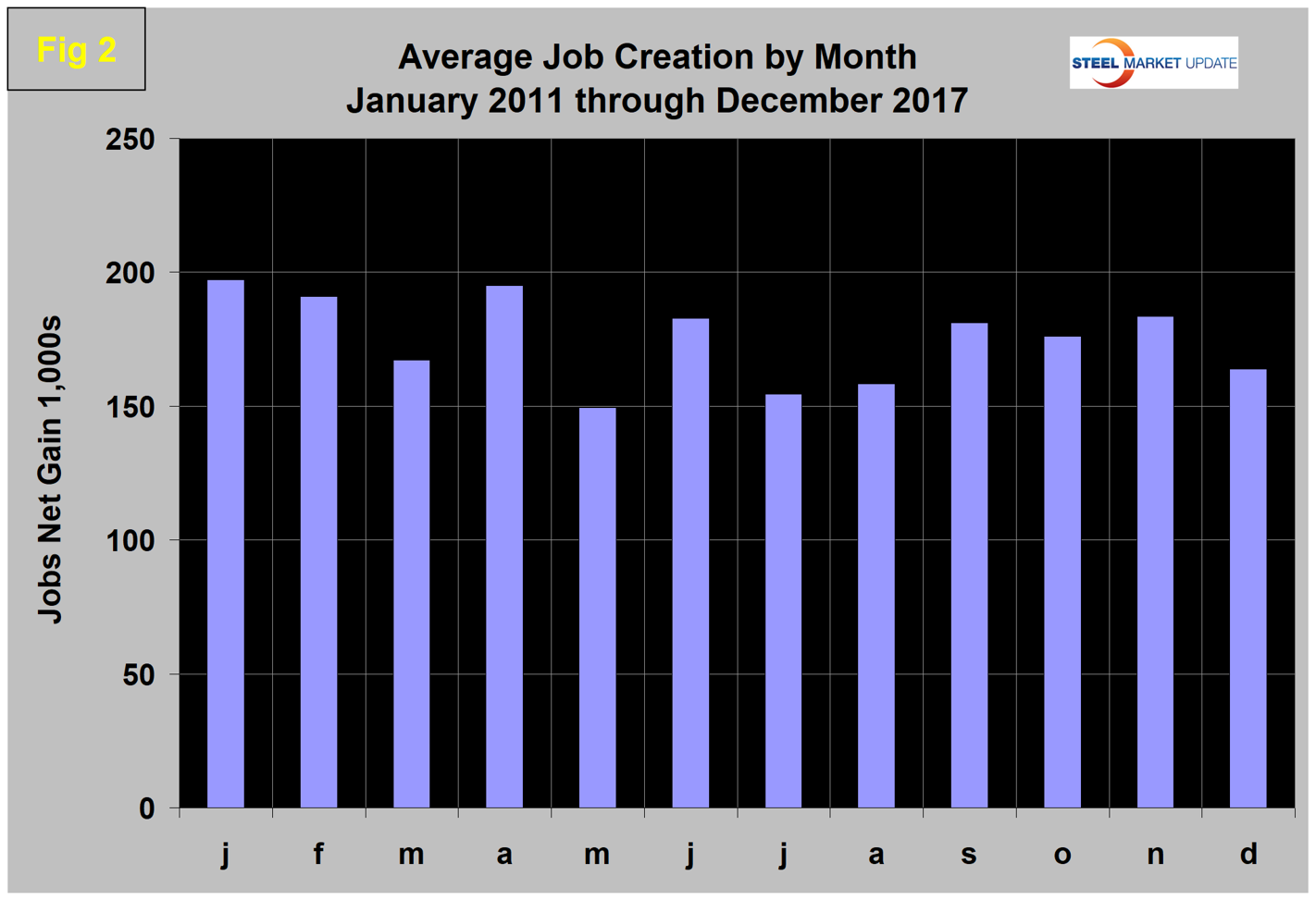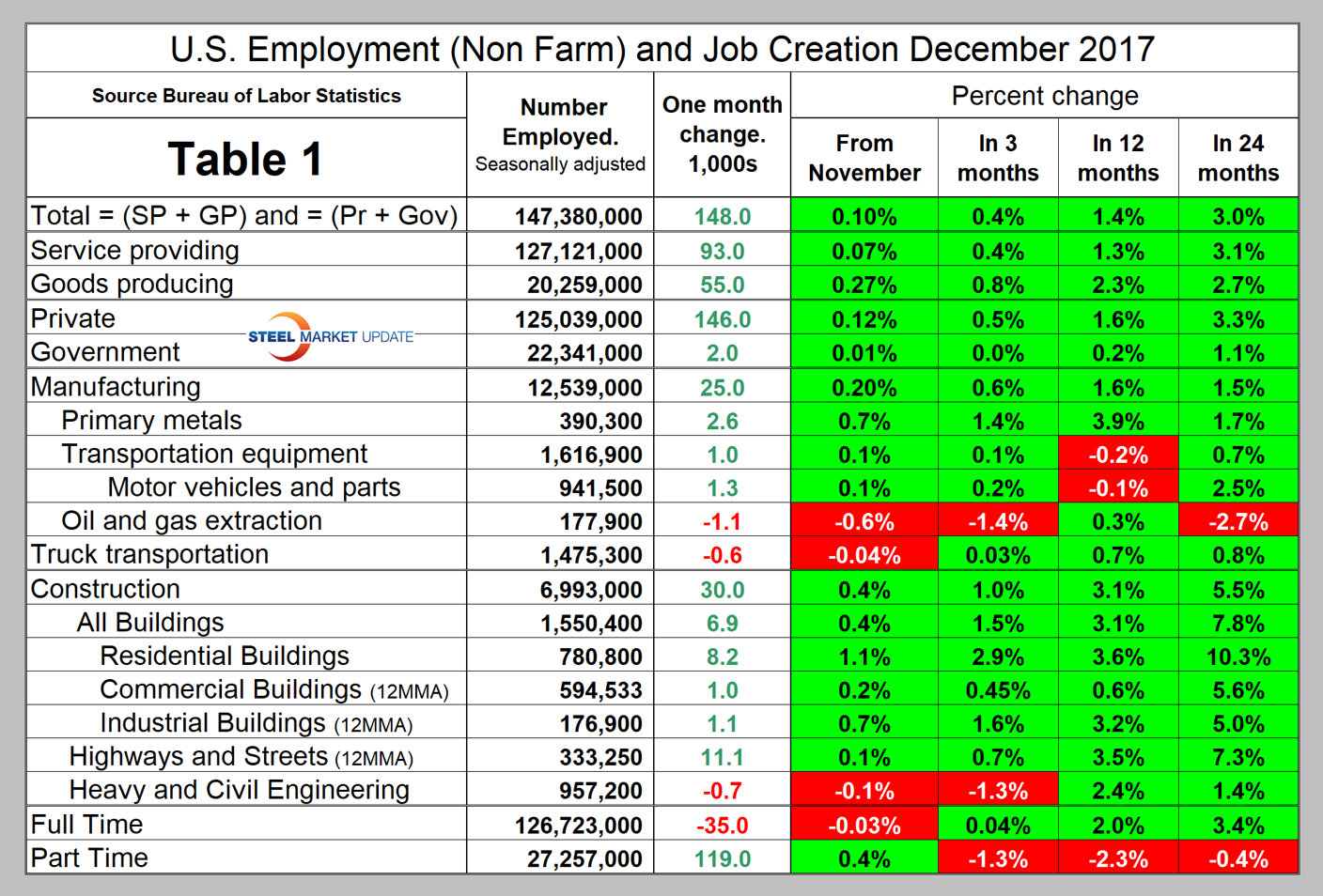Market Data

January 10, 2018
BLS: December Jobs Report Below Expectations
Written by Peter Wright
While the December jobs report was a bit disappointing, it still represents the 85th consecutive month of job growth and left the unemployment rate unchanged.
The Bureau of Labor Statistics (BLS) employment report for December was released on Friday. The total number of nonfarm jobs created was 148,000. October was revised down by 33,000 and November revised up by 24,000. Using a three-month moving average (3MMA), the December result was 204,000, up from 167,000 in November. The reason the 3MMA jumped so much was that the very low hurricane-driven result for September rolled out of the calculation.
Economy.com summarized as follows: “The year ended on a somewhat disappointing note. Payroll employment increased by 148,000, which was less than expected. A decline in retail trade and a modest gain in professional and business services explain the result. Revisions for October and November essentially canceled each other out. The unemployment rate was unchanged at 4.1 percent. Participation was also unchanged at 62.7 percent, as was the employment-to-population ratio at 60.1 percent. Some acceleration in wage growth, though expected, was a welcome sign. Earnings rose by 0.3 percent and nearly 2.6 percent year over year.”
Figure 1 shows the 3MMA of the number of jobs created monthly since 1990 as the brown bars and the total number employed as the white line. These numbers are seasonally adjusted by the BLS, which has been criticized in the past for the ineffectiveness of its seasonal adjustment calculations.

To examine if any seasonality is left in the data after adjustment, we have developed Figure 2. In the seven years since and including 2011, job creation in December has been down by 11.0 percent. This year it was down by 41 percent, therefore disappointing. This was partly a payback for October and November, which both exceeded the historical performance, driven by the hurricane rebound.

Total nonfarm payrolls are now 9,015,000 more than they were at the pre-recession high of January 2008. November 2014 was the first month for total nonfarm employment to exceed 140 million, and in December was 147.4 million. The BLS reported that the average workweek for all employees on private nonfarm payrolls was unchanged at 34.5 hours in December. In manufacturing, the workweek edged down by 0.1 hour to 40.8 hours, while overtime remained at 3.5 hours. The average workweek for production and nonsupervisory employees on private nonfarm payrolls was unchanged at 33.8 hours. In December, average hourly earnings for all employees on private nonfarm payrolls rose by 9 cents to $26.63. Over the year, average hourly earnings have risen by 65 cents, or 2.5 percent. Average hourly earnings of private-sector production and nonsupervisory employees increased by 7 cents to $22.30 in December.
Table 1 breaks total employment down into service and goods-producing industries and then into private and government employees. Most of the goods-producing employees work in manufacturing and construction. The components of these two sectors that we consider to be most relevant to steel people are broken out in Table 1.

In December, 146,000 jobs were created in the private sector and government gained 2,000 jobs. The number employed by the federal government gained 1,000 to 2.8 million, state governments lost 4,000 for a total of 5.07 million and local governments gained 5,000 to reach a total of 14.47 million. Since February 2010, the employment low point, private employers have added 17,782,000 jobs as government has shed 135,000 (Figure 3).

In December, service industries expanded by 93,000 as goods-producing industries, driven mainly by construction and manufacturing, expanded by 55,000. This was the silver lining as the steel-consuming sectors both did well in December. Construction gained 30,000 compared to a monthly average of 16,000 in the first 11 months of the year, and manufacturing gained 25,000, also compared to an average 16,000-job gain. Since February 2010, service industries have added 15,015,000 and goods-producing 2,632,000 positions. This is part of the reason why wage growth has been slow since the recession, as service industries on average pay less than goods-producing industries such as manufacturing.
Table 1 shows that primary metals gained 2,600 jobs in December. On a percentage basis, primary metals rose more than twice as much as total manufacturing in the 12 months of 2017. Motor vehicles and parts industries gained 1,300 jobs in December, but over 12 months had a small net loss. Trucking lost 600 jobs in December, but in the 12 months of 2017 was up by 0.7 percent. Oil and gas extraction has been stalled since August 2016 with zero gain or loss in that time frame. Note the subcomponents of both manufacturing and construction shown in Table 1 don’t add up to the total because we have only included those we think have most relevance to the steel industry.
Construction was reported to have gained 30,000 jobs in December and is up by 3.1 percent in the last 12 months. Some of the major construction subcategories are routinely reported one month in arrears, which distorts the data in Table 1. These include industrial buildings, commercial buildings, and highways and streets. Construction has added 1,493,000 jobs and manufacturing 1,086,000 since the recessionary employment low point in February 2010 (Figure 4). Construction has leapt ahead of manufacturing as a job creator, but the growth of construction productivity is very low in contrast to manufacturing where historically it has been high. The difference is the difficulty of automating construction jobs.

The official unemployment rate, U3, reported in the BLS Household survey (see explanation below) came in at 4.1 percent, which was unchanged from October and November but down from 4.7 percent in December last year. This number doesn’t account for those who have stopped looking. The more comprehensive U6 unemployment rate dipped from 9.2 percent in December last year to 8.1 percent in this latest report (Figure 5). U6 includes individuals working part time who desire full-time work and people who want to work but are so discouraged they have stopped looking. The differential between these rates was usually less than 4 percent before the recession and in October fell below 4.0 percent for the first time since March 2008.

The employment participation rate at 62.7 percent in December was the same as October and November. We’re not sure what this is a percentage “of” because of the multiple descriptions of the labor pool. Another measure is the number employed as a percentage of the population, which we think is more definitive. In December, this measure was 60.1 percent, up from 59.7 percent in December last year and from 59.5 percent in December 2015. The employment-to-population ratio stalled for most of last year, but has made progress in 2017. Figure 6 shows both measures on one graph.

In the 34 months since and including January 2015, there has been an increase of 6,789,000 full-time and a gain of 911,000 part-time jobs. Figure 7 shows the rolling 12-month total change in both part-time and full-time employment. This data comes from the household survey in which part time is defined as less than 35 hours per week. Because the full-time/part-time data comes from the household survey and the headline job creation number comes from the establishment survey, the two cannot be compared in any particular month. To overcome the volatility in the part-time numbers, we must look at longer time periods than a month or even a quarter, which is why we look at a rolling 12 months for the full-time and part-time employment picture shown in Figure 7.

The job openings report known as JOLTS is reported on about the 10th of the month by the Federal Reserve and is over a month in arrears. Figure 8 shows the history of unfilled job openings through October when openings stood at 5,996,000, not far off the all-time high of 6,116,000 in June this year. There has been an improving trend since mid-2009.

Initial claims for unemployment insurance, reported weekly by the Department of Labor, flattened in 2017 with the exception of the hurricane-driven spike. New claims are at the lowest level since 1974. In the week ending Dec. 30, initial claims were 250,000 with a four-week moving average of 241,750 claims. This marks the longest streak since 1973 of initial claims below 300,000 (Figure 9).

The last piece of the employment puzzle is the Challenger report, which measures monthly job cuts (Figure 10). This data also tends to be quite erratic. Therefore, we again examine a rolling 12 months and can see that job cuts decreased for most of 2016 and continued their downward trend in 2017.

SMU Comment: Rising employment and wages are the basis of GDP growth because personal consumption accounts for almost 70 percent of GDP. Steel consumption is related to GDP, therefore to get a handle on this driver we need to be aware of changes to the employment picture. As we close out 2017, the employment situation is good, job openings are close to an all-time high, and new claims for unemployment are at a 44-year low. Manufacturing employment is 1.6 percent higher than this time last year, and construction employment is up 3.1 percent. The employment situation has been described as “full” by some analysts. December was the 85th consecutive month of job growth, but Figure 1 shows a slowing trend since the middle of 2014. If as reported there is a shortage of qualified employees, we can expect an increase in wage-driven inflation in the near future. The results for manufacturing and construction are sign posts for steel sales activity. 2018 is starting from a strong base.
Explanation: On the first Friday of each month, the Bureau of Labor Statistics releases the employment data for the previous month. Data is available at www.bls.gov. The BLS reports on the results of two surveys. The Establishment survey reports the actual number employed by industry. The Household survey reports on the unemployment rate, participation rate, earnings, average workweek, the breakout into full-time and part-time workers and lots more details describing the age breakdown of the unemployed, reasons for and duration of unemployment. At Steel Market Update, we track the job creation numbers by many different categories. The BLS database is a reality check for other economic data streams such as manufacturing and construction, and we include the net job creation figures for those two sectors in our “Key Indicators” report. It is easy to drill down into the BLS database to obtain employment data for many subsectors of the economy. For example, among hundreds of sub-indexes are truck transportation, auto production and primary metals production. The important point about each of these hundreds of data streams is in which direction they are headed. Whenever possible, we try to track three separate data sources for a given steel-related sector of the economy. We believe this gives a reasonable picture of market direction. The BLS data is one of the most important sources of fine-grained economic data that we use in our analyses. The states also collect their own employment numbers independently of the BLS. The compiled state data compares well with the federal data. Every three months, SMU examines the state data and provides a regional report, which indicates strength or weakness on a geographic basis. Reports by individual state can be produced on request.







